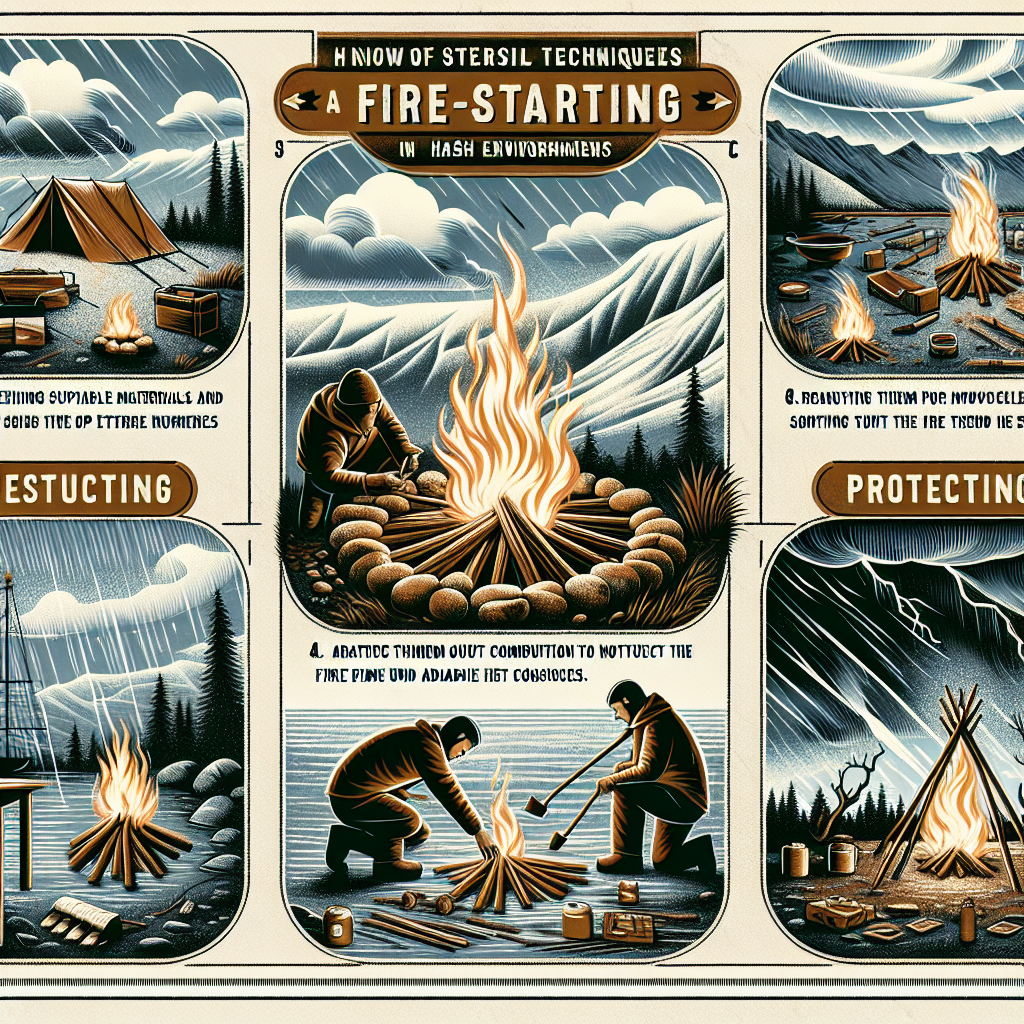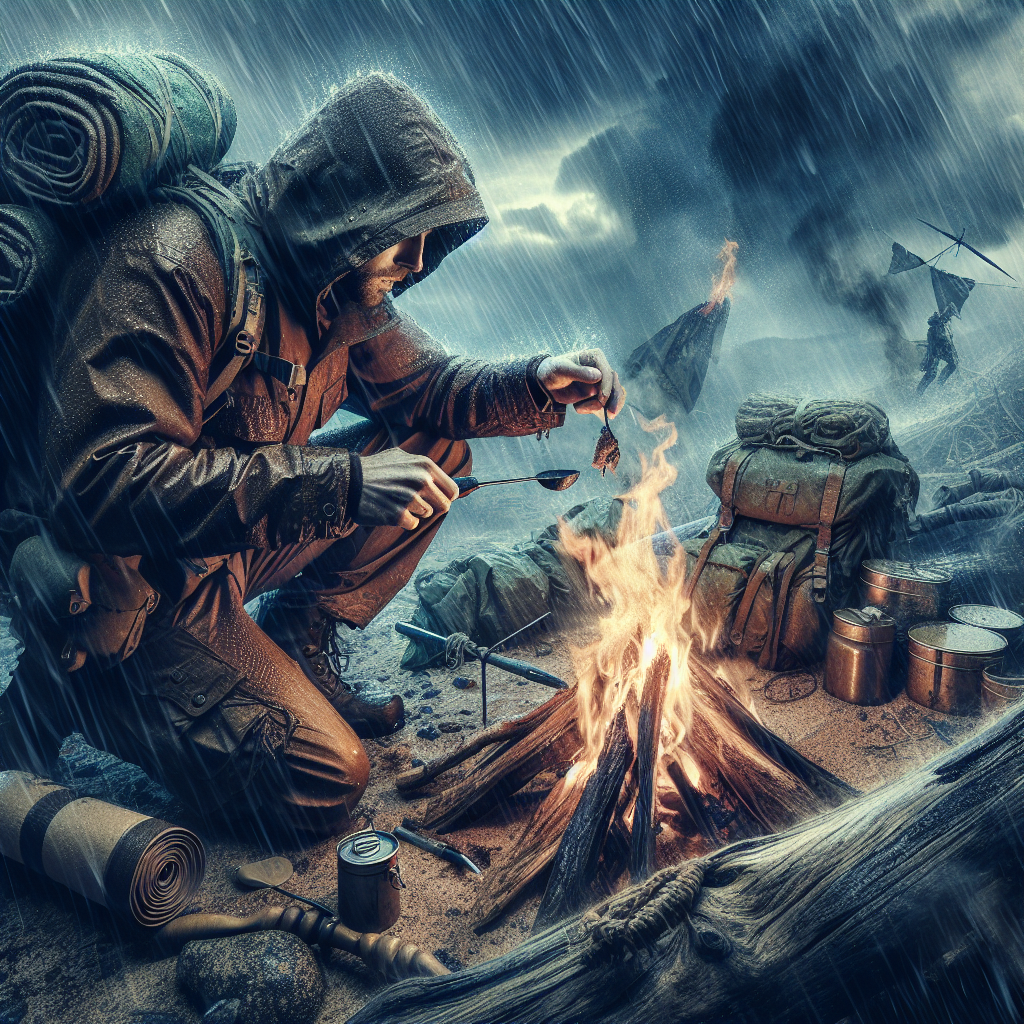Imagine yourself in a tough and unforgiving environment, surrounded by harsh conditions that make survival seem almost impossible. In these situations, one skill becomes vital: the ability to start a fire. In our article, “Fire Starting In Harsh Conditions: Techniques For Success,” we will explore various techniques and strategies that can help you overcome the challenges and achieve fire-starting success even in the toughest of circumstances. From understanding the importance of dry tinder to mastering the art of using natural materials, we will delve into the world of fire starting and equip you with the knowledge and skills needed to thrive in the wilderness. So get ready to ignite your curiosity and discover the secrets of conquering the elements with confidence.
Choosing the Right Location
When it comes to starting a fire, Choosing the right location is crucial for both safety and efficiency. Assessing the environment is the first step in this process. Look for an area that is clear of any dry grass or debris, as these can easily catch fire and spread. It is also important to consider the wind direction to avoid creating a hazard or blowing smoke into your face. Lastly, make sure to choose a location that is away from any overhanging branches or structures that can catch fire.
Finding suitable materials is the next step in choosing the right location. Look for an area with an abundant supply of firewood nearby. This will make it easier to gather and maintain the fire. Additionally, consider the availability of dry tinder and kindling, as these are essential for starting the fire. Lastly, take note of any natural hazards in the area, such as dead trees or loose rocks, that could pose a danger while collecting firewood or setting up the fire.
Gathering Firewood
Once you have chosen the right location, it’s time to gather firewood. The importance of firewood selection cannot be overstated. Look for dry, well-seasoned wood that is free of moisture. Wet or green wood can be difficult to ignite and produce excessive smoke. Hardwoods such as oak, maple, or birch are excellent choices as they burn longer and produce more heat. Softwoods like pine or spruce can be used as kindling but should not be relied upon as the main fuel source.
Tips for collecting firewood safely include wearing proper protective gear such as gloves and sturdy shoes. Be cautious of any sharp or protruding branches, as well as wildlife or insects that may be inhabiting the woodpile. Avoid gathering wood from areas where it is prohibited or protected, as this can have environmental consequences.

Preparation and Organization
Before starting the fire, it is important to prepare and organize the fire site. Clear the area of any flammable material by removing dry leaves, grass, and debris. This will create a safe zone for the fire. Next, create a fire pit by digging a shallow hole and surrounding it with rocks or bricks. This will help contain the fire and prevent it from spreading.
Gathering tinder, kindling, and fuel is essential for a successful fire. Tinder refers to small, easily ignitable materials such as dry leaves, bark, or wood shavings. Kindling consists of small sticks or twigs that will help the fire catch and spread. Fuel, on the other hand, refers to larger pieces of firewood that will keep the fire burning. It is important to gather enough of each material before starting the fire, as it can be difficult to find them once the fire has been ignited.
Preparing the fire materials involves arranging the tinder, kindling, and fuel in a strategic manner. Place the tinder in the center of the fire pit and loosely stack the kindling around it in a teepee or log cabin formation. Finally, lay the fuel on top of the kindling, making sure to leave enough space for air circulation. This will ensure that the fire starts easily and burns effectively.
Fire Starting Techniques
There are several techniques that can be used to start a fire. The most common method is using matches or lighters, which provide a quick and convenient way to ignite the fire. Simply hold the flame to the tinder until it catches, then carefully add more kindling and fuel to build up the fire.
Fire starters, such as firestarter cubes or waterproof matches, can also be used to easily ignite the fire. These are compact and lightweight, making them ideal for camping or survival situations. Simply light the fire starter and place it on the tinder, then add more kindling and fuel as needed.
For those looking for a more traditional and primitive approach, a fire bow drill or fire plough can be used. These techniques involve using friction to create an ember that can be transferred to the tinder bundle. While these methods require more skill and practice, they can be incredibly rewarding and useful in survival situations.
Lastly, a fire piston is a unique tool that uses the compression of air to ignite a fire. This technique involves rapidly pushing a plunger into a cylinder, creating enough heat to ignite the tinder. Fire pistons are compact and lightweight, making them a great addition to any survival kit.

Dealing with Wet Conditions
Starting a fire in wet conditions can be challenging but not impossible. There are several strategies that can help overcome the wetness and still successfully start a fire. The first step is to find dry tinder and kindling. Look for materials that are sheltered from the rain, such as under logs or rocks. Additionally, birch bark and fatwood are excellent natural fire starters that are highly flammable even when damp.
Creating a windbreak is also important in wet conditions. This can be done by building a shelter using a tarp or natural materials such as branches and leaves. This will protect the fire from wind and rain, allowing it to burn more effectively.
Building a raised firebed can also help in wet conditions. By elevating the fire off the ground, it reduces the chance of the firewood getting soaked. This can be done by constructing a platform using rocks or logs and then building the fire on top of it.
Using waterproof fire starters is another effective technique when dealing with wet conditions. These can be purchased or made at home using materials such as cotton balls soaked in petroleum jelly or candles. These will easily ignite even when wet, helping to start the fire.
Overcoming Windy Conditions
Windy conditions can make starting a fire more challenging, but with the right techniques, it can still be accomplished. Building windbreaks is the first step in overcoming windy conditions. This can be done by strategically placing rocks or logs on the windward side of the fire to shield it from the wind. This will create a more controlled environment and prevent the fire from being blown out.
Creating wind-resistant fire structures can also be helpful in windy conditions. This involves building a solid base for the fire by stacking rocks or building a small wall around it. This will help protect the fire from strong gusts of wind and maintain a steady flame.
Utilizing wind direction is another important technique. By positioning yourself and the fire in a way that takes advantage of the wind, you can ensure that the fire burns more efficiently. This can be done by facing the windward side while lighting the fire, allowing the wind to blow directly onto the tinder and kindling.
Tackling Snow and Cold
Starting a fire in snowy and cold conditions requires a different set of techniques. Removing snow from the fire area is the first step. This can be done by shoveling or using a small broom to clear a space for the fire. It is important to remove any snow down to the ground to prevent it from melting and extinguishing the fire.
Using insulating materials is essential in cold conditions. This can be done by placing a layer of rocks or logs on the ground before starting the fire. This will help to insulate the fire and prevent the heat from being lost to the cold ground.
Building underground fire structures is another technique that can be used in snowy and cold conditions. This involves digging a pit in the snow and then building the fire inside it. The snow acts as a natural insulator, allowing the fire to burn more efficiently and providing protection from the harsh elements.
Survival Fire Starting
In survival situations, starting a fire can be a matter of life and death. Picking the right survival fire starting technique is crucial. Depending on the resources available and the circumstances, different techniques may be more suitable. It is important to be familiar with a variety of fire starting techniques and to practice them regularly to ensure success in survival situations.
Ensuring fire safety in survival situations is equally important. Make sure to clear a safe zone around the fire and have a way to extinguish it if necessary. Use caution when handling flammable materials and keep a safe distance from the fire to prevent accidents. Always prioritize your safety when Starting a fire in survival situations.
Using signaling fires in emergencies is another application of fire starting skills. Signal fires can help search and rescue teams locate you in case of an emergency. Build a large, visible fire using flammable materials such as green vegetation or brightly colored fabric. Make sure the fire is in an open area, away from any overhanging branches or structures.
Fire Starting Tools and Equipment
Having the right tools and equipment is essential for successful fire starting. Essential fire starting tools include matches, lighters, and fire starters. It is important to have multiple sources of ignition to ensure success in various conditions. Waterproof matches, firestarter cubes, and magnesium fire starters are compact and lightweight options that are ideal for outdoor adventures.
Alternative fire starting tools can also be used in certain situations. These include items such as flint and steel, ferrocerium rods, or magnifying glasses. These tools rely on different mechanisms to create sparks or focus the sun’s rays, allowing for fire ignition. It is important to practice using these tools before relying on them in survival situations.
Choosing the right fire starter for the situation is crucial. Consider factors such as weather conditions, available resources, and personal preference when selecting a fire starter. It is also important to ensure that the fire starter is reliable, easy to use, and lightweight for ease of carrying.
Practice, Persistence, and Preparedness
Fire starting is a skill that requires practice, persistence, and preparedness. Regular fire starting practice is important to build and maintain the necessary skills. Spend time practicing different fire starting techniques in various conditions, such as wet or windy environments. This will help improve your proficiency and increase your chances of success in real-life situations.
Developing patience and persistence is also key in fire starting. It may take several attempts to successfully start a fire, especially in challenging conditions. Stay focused, remain calm, and continue to adjust your technique until you achieve the desired results. Remember that persistence is key in overcoming any obstacles that may arise.
Being prepared for unexpected situations is crucial when it comes to fire starting. Always carry a fire starting kit with you, which should include multiple sources of ignition, fire starters, and essential tools. Additionally, familiarize yourself with local regulations and restrictions regarding fire starting to ensure compliance and prevent any accidents or damage to the environment.
By following these techniques and tips, starting a fire in harsh conditions can become a manageable task. Remember to prioritize safety, be resourceful, and practice regularly to increase your confidence and success in fire starting.
